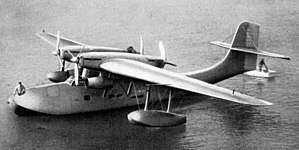Lioré et Olivier LeO H-47
The Lioré et Olivier LeO H-47 was a flying boat airliner built in France in 1936. It was designed to operate passenger services over the South Atlantic, but the outbreak of the Second World War caused the type to be used by the French Navy as a maritime patrol aircraft.[1]
| LeO H-47 | |
|---|---|
 | |
| Role | Airliner |
| National origin | France |
| Manufacturer | Lioré et Olivier |
| First flight | 25 July 1936 |
| Retired | 1943 |
| Number built | 6 |
Development and design
In 1934, the French air ministry issued a specification for a long-range flying boat to be used by Air France on services over the South Atlantic between Dakar in Senegal and Natal in Brazil. As such, the specification required that the new transport be capable of flying 3,000 kilometers (1,900 mi) at a speed of 250 km/h (155 mph) while carrying a payload of 1,000 kilogrammes (2,200 lb). Lioré et Olivier received an order for a prototype of its design to meet this specification, the LeO H-47 on 10 August 1935.[2]
The H-47 was a conventional high-wing design with the cabin and flight deck fully enclosed within a streamlined hull. The four engines were mounted in two tractor-pusher pairs above the wing.
The prototype H-47 first flew from Antibes on 25 July 1936,[3] and was destroyed in a crash in May 1937 that was attributed to a wingtip float breaking away whilst the aircraft was in flight.[4] Nevertheless, Air France went ahead with the purchase of five similar (though strengthened) machines, designated H-470, which were put into service as mail planes.[1] These machines were impressed into the French Navy at the outbreak of the Second World War.[1]
The four remaining aircraft remained in use with the Vichy French Navy following the French Armistice, servings as transports between France and Tunisia, before being transferred to Dakar in Senegal in June 1941. The last H-470 was scrapped in August 1943 when stocks of spares ran out.[5]
Specifications
General characteristics
- Crew: Two pilots
- Capacity: 12 passengers
- Length: 21.20 m (69 ft 7 in)
- Wingspan: 31.80 m (104 ft 4 in)
- Height: 7.10 m (23 ft 4 in)
- Wing area: 135.0 m2 (1,452 sq ft)
- Empty weight: 10,465 kg (23,023 lb)
- Gross weight: 19,713 kg (43,389 lb)
- Powerplant: 4 × Hispano-Suiza 12Ydrs , 650 kW (860 hp) each
Performance
- Maximum speed: 360 km/h (225 mph, 196 kn)
- Range: 3,200 km (2,000 mi, 1,700 nmi)
- Service ceiling: 7,000 m (23,000 ft)
Notes
- Taylor 1989, p. 580
- Stroud 1992, p. 49.
- Green 1968, p.46.
- Flight 14 October 1937, p.374
- Green 1968, p.48.
References
| Wikimedia Commons has media related to Lioré et Olivier LeO H-47. |
- Green, William (1968). War Planes of the Second World War: Volume Five Flying Boats. London: Macdonald. ISBN 0 356 01449 5.
- Stroud, John (1966). European Transport Aircraft since 1910. London: Putnam.
- Stroud, John. "Wings of Peace: Lioré et Olivier H 47 and H 246". Aeroplane Monthly. No. January 1992. pp. 48–52.
- Taylor, Michael J. H. (1989). Jane's Encyclopedia of Aviation. London: Studio Editions.
- "Civil Types in Paris". Flight. 19 November 1936. p. 552. Retrieved 2008-10-02.
- "For the South Atlantic". Flight. 22 October 1936. p. 419. Retrieved 2008-10-02.
- "Atlantic Aspirants". Flight. 14 October 1937. pp. 372–376. Retrieved 2008-10-02.